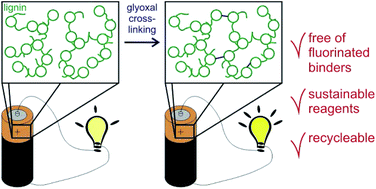More sustainable energy storage: lignin based electrodes with glyoxal crosslinking†
Abstract
Lignin is a promising material to be used in sustainable energy storage devices. It may act as an active component due to hydroquinone motifs or as a binder in electrodes. While usually it is blended or modified with unsustainable chemicals, we investigate crosslinking with glyoxal as a new route to obtain more benign electrodes. For combining the advantages of high charge (lignin as an active material) and electrode stability (lignin as a binder), we chose a two-step process in which we first form lignin–carbon composites and subsequently crosslink lignin on the carbon. We discuss crosslinking of the material as well as influences on charge storage. Final electrodes benefit from combined faradaic and non-faradaic charge storage and reach a capacity of 80 mA h g−1 at a discharge rate of 0.2 A g−1.



 Please wait while we load your content...
Please wait while we load your content...